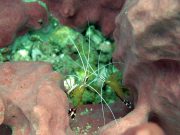Diving with Anemone Shrimp
Lanta Marine Life | Hippolytidae
The Anemone Shrimp, also known as Cleaner Shrimp, Hump-back Shrimp, or Broken-back Shrimp, are a large family of over 330 species, including several species of cleaner shrimp. A small number of these species can be found during Koh Lanta diving.
Anemone Shrimp feed on algae and plankton, and are often spotted in small colonies blending in with their hosts. They can be found on algae, anemones, soft corals, sea whips and hard corals.
Some species of Hippolytidae can grow up to 8cm and are found world-wide, in both shallow marine and fresh water habitats.
They have 10 pairs of legs, with the front two pairs having pincers used for cleaning. The first (primary) pair of pincers are much larger than the second )secondary) pair of pincers.
2 species found on this page:
Marbled Shrimp
(Saron marmoratus)

Saron marmoratus @ Koh Haa
The Marbled Shrimp has a dumpy body and distinct colouration. The rostrum (beak) is slightly longer than the main body, and the body colours vary widely, with a mostly brownish to reddish under colour, decorated with pinkish to bluish to whitish bands, spots and other mottled markings.
Colouration and patterns can be quickly changed for camouflage, though the colouration is generally ‘marbled’. The legs are generally always dark and white banded.
The dorsal area and abdomen or Marbled Shrimp have many tufts of hair-like bristles (setae), which are more dense in females. Females also have thick brush-like tufts of bristles on the first pair of legs.
The Marbled Shrimp is often found hiding in corals and around coral rubble and is capable of moving very quickly when necessary.
White-Banded Cleaner Shrimp
(Lysmata amboinensis)

Lysmata amboinensis @ Koh Haa
White-Banded Cleaner Shrimp, or Scarlet Cleaner Shrimp, has amber coloured body and legs. The top of the head and the carapace (rear body shell) is a deep reddish colour, with a long white stripe from the tip to the head to the tail base.
The tail is similarly coloured, with two white spots on each side of the tail and a central white triangle.

Lysmata amboinensis @ Koh Haa
The White-Banded Cleaner Shrimp has several long white antennae and the two front cleaning arms are also white
They can grow to 5 cm, with the diet including parasites and dead tissue from fish.
Diving with Anemone Shrimp around Koh Lanta
Scuba Diving & Snorkel Trips
If you'd love a chance to spot Anemone Shrimp on one of our daily high season diving trips from Koh Lanta then send us an email to info@diveandrelax.com.
Join our high season speedboat dive trips to some of Thailand's best dive sites and enjoy small groups, short journey times, with a focus on great personal service, safety and fun.
Not yet a certified diver? Learn to Scuba Dive on Koh Lanta with the 3 day SSI Open Water Diver course.
Book online to save 10% on dive trips and scuba courses on Koh Lanta.
Find Out More
Indo-Pacific Marine Life Guides
- Allen, G., Steene, R., Humann, P., DeLoach, N. (2003) Reef Fish Identification, Tropical Pacific. Jacksonville, FL., USA: New World Publications, Inc., ISBN 1-878348-36-1.
- Humann, P., DeLoach, N., (2010) Reef Creature Identification, Tropical Pacific. Jacksonville, FL., USA: New World Publications Inc., ISBN 978-1-878348-44-9
- Debelius, H. (2013) Indian Ocean Reef Guide. Frankfurt, Germany: IKAN - Unterwasserarchiv, ISBN 978-3-939767-52-7.
- Debelius, H. (2004) Nudibranchs and Sea Snails, Indo-Pacific Field Guide. Frankfurt, Germany: IKAN - Unterwasserarchiv, ISBN 3-925919-51-1
- Erhardt, H., Knop, D. (2015) Corals Indo-Pacific Field Guide. Frankfurt, Germany: IKAN - Unterwasserarchiv, ISBN 3-925919-69-4.
- Veron J.E.N., Stafford-Smith M.G., Turak E. and DeVantier L.M. (2016). Corals of the World
